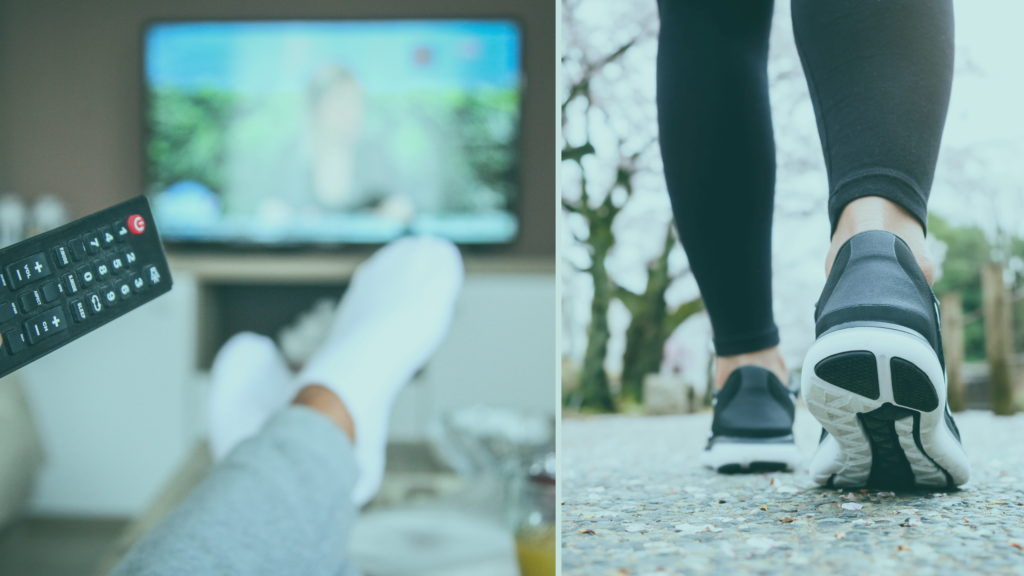
Renee Wheller
Exercise Physiologist, Healthy Connections
With recent global events (COVID-19), people are spending longer hours at home and likely adopting more sedentary lifestyles. I think a lot of us would agree that during this time it has been a lot harder to avoid long bouts of sitting.
I have been adjusting to a change in my work environment; now spending more time on a computer instead of standing or walking around. I also feel that since sport has stopped and my gym has closed, motivation to perform 30-60 minutes of daily exercise is even harder!
I’m sure some of you are feeling the same way… So to stop us all from becoming couch potatoes during this crisis, I thought what better way to motivate us to sit less and move more than to discuss the impacts prolonged sitting has on our health.
And let me tell you…after reading this blog you will be standing and going for a walk in no time!

Impact of sedentary behaviour
Although we tend to be aware of the acute effects prolonged sitting has on our health e.g. lower back pain. We don’t always think about the long–term health effects. There is an extensive amount of research that investigates the negative health impacts of sedentary behaviours. Excessive sitting has been identified as an independent risk factor for many chronic conditions such as cardio-metabolic disorders, coronary artery disease, type 2 diabetes, obesity, musculoskeletal disorders – back pain, some cancers and premature death [1].
Prolonged sitting and obesity
Prolonged sitting is associated with reduced energy expenditure and a lack of muscle usage. This ultimately suppresses the activity of a fat-burning enzyme lipoprotein lipase and effects the production of HDL (good cholesterol). Lipoprotein lipase breaks down fat into the form of triglycerides. Once the triglycerides are broken down, the fat molecule can be transported (by HDL) to be used by the body as energy or stored in fatty tissue for later use [1].
The more we sit, the less we move, the more fat we will store!
Prolonged sitting and T2DM
Excessive fat tissue can lead to an increase in insulin resistance. Insulin is a hormone that helps control the about of sugar (glucose) in the blood. With insulin resistance, cells within our body don’t respond normally to insulin. This means that glucose can’t enter the cells as easily and builds up in the blood [4].
Our muscles use glucose as energy to contract. When we are sitting for long hours we aren’t contracting our muscles efficiently, therefore, glucose will remain in the bloodstream and likely be stored as fat. These processes over time can lead to Type 2 Diabetes and other chronic conditions [1,4].
So are you standing yet?
Prolonged sitting and cardiovascular disease
Impaired glucose metabolism can result in the deposit of fat (plaque) within the artery walls. This build up can lead to increase blood pressure (Hypertension) which is a primary risk factor for cardiovascular disease [1]. Many studies have shown that those who spend long hours sitting (office workers) have increased blood pressure compared to those who sit less and move more. Surprisingly the position of sitting impacts our cardiovascular system as it can compress major blood vessels in the body resulting in lower limb swelling and reduced circulation [1].
But why does blood pressure actually increase?
If we are not moving regularly, there is a reduced metabolic demand by the blood vessels in the muscles. If blood is not being regularly pumped through these tiny vessels, then they can constrict and close. This constriction means the body has to work harder to circulate blood showing an increase in blood pressure. Long-term stress on the cardiovascular system will lead to increase pressure on the heart and may result in a cardiac event [2].
Prolonged sitting and musculoskeletal disorders
“Use it or lose it!”
Our bodies are not designed to be in a sitting position for long periods. Hence why after a while we tend to adapt poor postural positions. Hunched posture increases pressure on the spine and weakens the muscle around the trunk & pelvis e.g. back, core and glutes [1]. The position of sitting can also lead to particular muscles tightening such as the neck, chest, hip flexors, hamstring and calf muscles. These changes can lead to muscle wastage, joint pain e.g. lower back pain and reduce functional capacity. Chronic pain is also likely to lead to mental health concerns such as depression and anxiety [3].
Here is a great five-minute video that summarizes some of the impacts we have discussed today.
I’m hoping that you have all stood up to finish reading this blog and you all have a great understanding of how harmful prolonged sitting is for our health!
So how do we best combat this sitting issue you ask?
Well, you will have to wait for next week’s blog! Next week we are going to investigate the role of physical activity, compare sitting to standing and discuss the benefits of regular movement breaks. We will also be sharing some easy workouts that you can perform to break up sitting time.
Stay Tuned!
Renee
As university-trained exercise physiologist, we use evidence from high-quality research studies to support our recommendations so many of these blogs will refer to research journal articles. If you would like to know more about this topic and the studies cited in this blog, please refer to reference below.
References
- Daneshmandi, H., Choobineh, A., Ghaem, H., & Karimi, M. (2017). Adverse Effects of Prolonged Sitting Behavior on the General Health of Office Workers. Journal Of Lifestyle Medicine, 7(2), 69-75. doi: 10.15280/jlm.2017.7.2.69
- Dempsey, P., Larsen, R., Dunstan, D., Owen, N., & Kingwell, B. (2018). Sitting Less and Moving More. Hypertension, 72(5), 1037-1046. doi: 10.1161/hypertensionaha.118.11190
- Holmes, A., Christelis, N., & Arnold, C. (2013). Depression and chronic pain. Medical Journal Of Australia, 199(S6). doi: 10.5694/mja12.10589
- Information, H., Overview, D., Diabetes?, W., Prediabetes, I., Prediabetes, I., Center, T., & Health, N. (2020). Insulin Resistance & Prediabetes | NIDDK. Retrieved 9 April 2020, from https://www.niddk.nih.gov/health-information/diabetes/overview/what-is-diabetes/prediabetes-insulin-resistance



